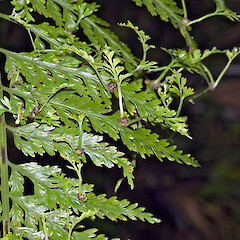Asplenium bulbiferum
Common name
hen and chicken fern, pikopiko, mother spleenwort
Synonyms
Asplenium marinum var. bulbifera (G.Forst.) F.Muell.; Caenopteris bulbifera (G.Forst.) Desv.;
Family
Aspleniaceae
Flora category
Vascular – Native
Endemic taxon
Yes
Endemic genus
No
Endemic family
No
Structural class
Ferns
NVS code
The National Vegetation Survey (NVS) Databank is a physical archive and electronic databank containing records of over 94,000 vegetation survey plots - including data from over 19,000 permanent plots. NVS maintains a standard set of species code abbreviations that correspond to standard scientific plant names from the Ngä Tipu o Aotearoa - New Zealand Plants database.
ASPBUL
Chromosome number
2n = 144
Current conservation status
The conservation status of all known New Zealand vascular plant taxa at the rank of species and below were reassessed in 2017 using the New Zealand Threat Classification System (NZTCS) – more information about this can be found on the NZTCS website. This report includes a statistical summary and brief notes on changes since 2012 and replaces all previous NZTCS lists for vascular plants.
Please note, threat classifications are often suggested by authors when publications fall between NZTCS assessment periods – an interim threat classification status has not been assessed by the NZTCS panel.
- Conservation status of New Zealand indigenous vascular plants, 2017 . 2018. Peter J. de Lange, Jeremy R. Rolfe, John W. Barkla, Shannel P. Courtney, Paul D. Champion, Leon R. Perrie, Sarah M. Beadel, Kerry A. Ford, Ilse Breitwieser, Ines Schönberger, Rowan Hindmarsh-Walls, Peter B. Heenan and Kate Ladley. Department of Conservation. Source: NZTCS and licensed by DOC for reuse under the Creative Commons Attribution 4.0 International licence.
2017 | Not Threatened
Previous conservation statuses
2012 | Not Threatened
2009 | Not Threatened
2004 | Not Threatened
Distribution
Endemic. New Zealand: North Island, South Island, Stewart Island/Rakiura, Chatham Islands.
Habitat
Coastal to subalpine. Usually in lowland forest where it is a common species of the ground-layer, especially in high rainfall areas. Commonly associated with riparian forest, and as a species of base-rich substrates. Frequently sympatric and so commonly forming hybrids with other asplenia. It is commonly sympatric with A. gracillimum Colenso.
Wetland plant indicator status rating
Information derived from the revised national wetland plant list prepared to assist councils in delineating and monitoring wetlands (Clarkson et al., 2021 Manaaki Whenua – Landcare Research Contract Report LC3975 for Hawke’s Bay Regional Council). The national plant list categorises plants by the extent to which they are found in wetlands and not ‘drylands’. The indicator status ratings are OBL (obligate wetland), FACW (facultative wetland), FAC (facultative), FACU (facultative upland), and UPL (obligate upland). If you have suggestions for the Wetland Indicator Status Rating, please contact: [Enable JavaScript to view protected content]
UPL: Obligate Upland
Rarely is a hydrophyte, almost always in uplands (non-wetlands).
Detailed description
Rhizome short, stout, erect, bearing ovate scales up to 15 × 5 mm. Stipes 50–300 mm long, brown on underside, green above, stout, covered in small brown ovate scales. Laminae lanceolate to elliptic, 0.15–1.20 m, 70–300 mm, bi- to tripinnate, sometimes bearing bulbils. Raches pale green to yellow-green, scaly, prominently grooved. Pinnae 15–30 (or more) pairs, ovate to narrowly ovate, acuminate, shortly stalked, 30–200 × 10–50 mm, scaly on underside, basal pair pointing downwards when fresh. Secondary pinnae sessile or shortly stalked, very narrowly elliptic to ovate or elliptic, obtuse, deeply serrate or sometimes almost pinnate, decreasing in size from base to apex, basal acroscopic pinnule often enlarged (up to 40 × 10 mm). Ultimate pinnules narrowly oblong, ± entire to crenate-serrate, up to 10 mm long. Sori numerous, broad, submarginal, 2–4 mm long.
Similar taxa
Asplenium bulbiferum, the world famous hen & chicken fern is only ever likely to be confused with the closely related A. gracillimum. From that species it is distinguished by its usually bulbiferous; mostly pale green fronds and ovate stipe scales which lack long filiform apices. Asplenium bulbiferum is a tetraploid (2n = 144) and A. gracillimum an octoploid (2n = 288), so hybrids between these two species are sterile.
Propagation technique
Easily grown, and popular in cultivation. However, most plants sold as this species are the sterile hybrid A. ×lucrosum Perrie et Brownsey (A. bulbliferum × A. dimorphum Kunze). An excellent pot plant but as with all asplenia prone to infestations of scale and mealy bugs.
Etymology
asplenium: From the Greek a- ‘without’ and splene ‘spleen’, a northern hemisphere species, the black spleenwort (Asplenium adiantum-nigrum), was once believed to be a cure for diseases of the spleen.
bulbiferum: Bearing bulbills or bulbs
Where To Buy
Commonly sold by many plant nurseries. However some plants sold as this species are in fact a sterile hybrid A. x lucrosum (A. bulbiferum x A. dimorphum).
Attribution
Fact Sheet prepared for NZPCN by P.J. de Lange (3 February 2005). Description from: Brownsey (1977)
References and further reading
Brownsey PJ. 1977. A taxonomic revision of the New Zealand species of Asplenium. New Zealand Journal of Botany 15(1): 39–86. https://doi.org/10.1080/0028825X.1977.10429618.
NZPCN Fact Sheet citation
Please cite as: de Lange, P.J. (Year at time of access): Asplenium bulbiferum Fact Sheet (content continuously updated). New Zealand Plant Conservation Network. https://www.nzpcn.org.nz/flora/species/asplenium-bulbiferum/ (Date website was queried)











